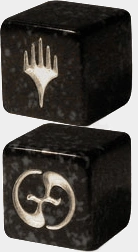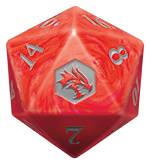Dice rolling
- "Die" redirects here. For the process of putting a creature in the graveyard from the battlefield, see Dies.
| Rolling a Die | |
|---|---|
|
[[File:{{#setmainimage:Unsanctioned die.png}}|70x70px]] | |
| Mechanic | |
| Introduced | Unglued |
| Last used | Dungeons & Dragons: Adventures in the Forgotten Realms |
| Statistics |
89 cards |
| Scryfall Search | |
| fulloracle:"(-sided|d20|d4|d6|d8|d10|d12)" | |
Dice rolling is a mechanic that creates a random effect in game play.[1]
Description
Dice rolling formerly was not part of the official Magic rules for the regular game, but had been used in supplemental sets and was considered for Battle for Zendikar.[2][3] With its introduction in Adventures in the Forgotten Realms it became a black-bordered mechanic.
History
Unglued
The rolling of a regular six-sided die as a mechanic was used on Magic cards in Unglued, and proved to be unpopular.[4][5] Ever since, bringing specifically six-sided dice to black border is something R&D has consciously chosen not to do.[6]
Planechase

Planechase introduced the six-sided planar die, that features the planeswalker symbol ![]() on one face, the chaos symbol
on one face, the chaos symbol ![]() on another and four blank faces.[7]
on another and four blank faces.[7]
In a Planechase game, the active player can roll the planar die as a special action any time they could cast a sorcery. The first roll per turn costs ![]() , the second costs
, the second costs ![]() , the third costs
, the third costs ![]() , and so on.
, and so on.
Fractured Powerstone is a card that allows to roll the planar die. It is also the only black-bordered card which refers to rolling a die.
From the glossary of the Comprehensive Rules (June 7, 2024—Modern Horizons 3)
- Planar Die
- A specialized six-sided die needed to play the Planechase casual variant. See rule 901.3.
From the glossary of the Comprehensive Rules (June 7, 2024—Modern Horizons 3)
- Chaos Ability
- An ability of a plane card that triggers “Whenever chaos ensues” in the Planechase casual variant. See rule 311.7.
Battle for Zendikar
One of the mechanics that was considered for the Eldrazi in Battle for Zendikar was hedronize. Hedronize was a keyword action where the player rolled an hedron-shaped (eight-sided) die to get an effect. Thus, hedronize had eight abilities – you roll a die and you do one of eight things (gain life, produce a spawn, etc.). The rules card that would have come in the pack would list them. The mechanic didn’t really play well because it was a little too chaotic.[8][9][10] Nonetheless, there were 8-sided Hedron dice given out at PAX.[11]
Amonkhet

Players who attended Amonkhet prerelease were rewarded pyramid-shaped (four-sided) "lazotep" dice for each trial they completed. These were also awarded in the Magic League. The dice (or counters) could be used to keep track of -1/-1 counter on their cards.[12]
Unstable
Sword of Dungeons & Dragons from Unstable makes a cross-over with Dungeons & Dragons and uses a D20 (twenty-sided die). Other cards again used dice rolling with regular dice. Mark Rosewater had reevaluated dice rolling and had decided that it could be popular if R&D was careful about how the cards were designed.[13][14] In Unstable, blue manipulates dice. Black magnifies dice. Red rolls the most dice. And green cares about what is rolled. White has a little dice rolling but doesn’t mechanically interact with it. What colors you draft affects how you may interact with dice rolling.[15]
Unsanctioned
Dice rolling was also used in Unsanctioned.[16] In addition, Pippa, Duchess of Dice creates green Die creature tokens with power and toughness each equal to the result of a die roll.
Dungeons & Dragons: Adventures in the Forgotten Realms

Inspired by the Dungeons & Dragons-game, Adventures in the Forgotten Realms introduced dice rolling in black-bordered sets.[17] The bundle of the set come with a D20, a twenty-sided die. This is the signature die of Dungeons & Dragons, and also the only sort of die connected to the main set. Cards that ask you to Roll a d20 have a results table to show you what may happen.[18][19] With the exception of Delina, Wild Mage and Treasure Chest, the dice rolling is partitioned with the lower bracket as 1-9, and the upper bracket is either 10-20 or 10-19 with 20 as a special powered version. The baseline effect at 1-9 is slightly improved in the 10-20 variant, usually by a unit of one (an extra token, a higher value of scry, another life) and very few directly affect combat math.
The Commander Decks released with the Forgotten Realms set utilize the other commonly used dice in Dungeons & Dragons. Those are the other Platonic solids and a pentagonal trapezohedron which is a 10-sided shape. As the d20, these dice are typically abbreviated by attaching their face count to the letter "d": d4, d6, d8, d10, and d12. Note that only a D&D set would write it that way. The default is “#-sided die”.[20]
Rulings
- Each die is identified by the number of faces it has. For example, a d20 is a twenty-sided die. Each die must have equally likely outcomes and the roll must be fair. Although physical dice are recommended, digital substitutes are allowed, provided they have the same number of equally likely outcomes as specified in the original roll instruction.
- An ability that tells you to roll a die will also specify what to do with the result of that roll. Most often, this is in the form of a "results table" in the card text.
- The instruction to roll a die and the effect that occurs because of the result are all part of the same ability. Players do not get the chance to respond to the ability after knowing the result of the roll.
- An effect that says "choose a target, then roll a d20" or similar still uses the normal process of putting an ability on the stack and resolving it. Choosing targets is part of putting the ability on the stack and rolling the d20 happens later, as the ability resolves.
- Some effects may modify the result of a die roll. This may be part of the instruction to roll a die or it may come from other cards. Anything that references the "result" of a die roll is looking for the result after these modifications. Anything that is looking for the "natural result" is looking for the number shown on the face of the die before these modifications.
- Some abilities, like that of Pixie Guide and Barbarian Class, replace rolling a die with rolling extra dice and ignoring the lowest roll. The ignored rolls are not considered for the effect that instructed you to roll a die, and do not cause abilities to trigger. For all intents and purposes, once you determine which dice count, the extra dice were never rolled.
- Some effects instruct you to roll again. This uses the same number and type of dice as the original roll, and that roll will use the same set of possible outcomes.
- While playing Planechase, rolling the planar die will cause any ability that triggers whenever a player rolls one or more dice to trigger. However, any effect that refers to a numerical result will ignore the rolling of the planar die.
Dice interaction
- Barbarian Class — Roll X+1, ignore the lowest roll.
- Pixie Guide — Roll X+1, ignore the lowest roll.
- Silver-bordered
- As Luck Would Have It — Alternate-win card for dice rolling
- Boomstacker — Dice stacking dexterity card
- Goblin Bookie — Reroll a die (or reflip a coin)
- Krark's Other Thumb — Roll two, pick one
- Proper Laboratory Attire — Protection from die rolls
- Squirrel-Powered Scheme — Increase result by 2
- Wall of Fortune — Reroll a die
Gallery
-
MTG Companion dice roller
References
- ↑ Jess Dunks (July 12, 2021). "Adventures in the Forgotten Realms Release Notes". magicthegathering.com. Wizards of the Coast.
- ↑ Mark Rosewater (September 05, 2015). "I was under the impression that black border doesn't roll dice.". Blogatog. Tumblr.
- ↑ Mark Rosewater (September 05, 2015). "Do you see it happening anytime soon?". Blogatog. Tumblr.
- ↑ Mark Rosewater (May 04, 2009). "Kind Acts of Randomness". magicthegathering.com. Wizards of the Coast.
- ↑ Mark Rosewater (December 15, 2016). "What has kept die rolling out of black border Magic?". Blogatog. Tumblr.
- ↑ Mark Rosewater (June 08, 2017). "Do you think Jumbo Imp could get black bordered in some form?". Blogatog. Tumblr.
- ↑ magicthegathering.com staff (August 10, 2009). "Planechase Rules Revealed". magicthegathering.com. Wizards of the Coast.
- ↑ Mark Rosewater (August 31, 2015). "What were some mechanics for BFZ that just floundered?". Blogatog. Tumblr.
- ↑ Mark Rosewater (September 05, 2015). "What IS the hedronize mechanic?". Blogatog. Tumblr.
- ↑ Mark Rosewater (September 01, 2015). "What kind of things hedronize could do?". Blogatog. Tumblr.
- ↑ Mark Rosewater (September 05, 2015). "I'd still really love to get some Hedron dice.". Blogatog. Tumblr.
- ↑ Preview Your AKH Event Kits
- ↑ Mark Rosewater (November 20, 2017). "The Un-Ending Saga, Part 3". magicthegathering.com. Wizards of the Coast.
- ↑ Mark Rosewater (November 22, 2017). "Unstable FAQAWASLFAQPAFTIDAWABIAJTBT". magicthegathering.com. Wizards of the Coast.
- ↑ Mark Rosewater (March 11, 2018). "How do you keep each color from feeling monotonous with every deck doing everything". Blogatog. Tumblr.
- ↑ Mark Rosewater (February 25, 2020). "Unsanctioned FAQ". magicthegathering.com. Wizards of the Coast.
- ↑ Mark Rosewater (July 12, 2021). "D&D-esign, Part 2". magicthegathering.com. Wizards of the Coast.
- ↑ Matt Tabak (June 24, 2021). "Adventures in the Forgotten Realms Mechanics". magicthegathering.com. Wizards of the Coast.
- ↑ Corey Bowen (July 1, 2021). "Quest for the Dodecahedron". magicthegathering.com. Wizards of the Coast.
- ↑ Mark Rosewater (July 9, 2021). "Hey mark ive got some dice related questions for...". Blogatog. Tumblr.
